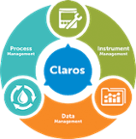-
Products
-
Lab Instruments
Titration Systems Other Instruments
-
Lab Meters and Probes
Calibration Standards Other Meters and Probes
- Chemistries, Reagents, and Standards
-
Online Analyzers
EZ Series Analysers
- Iron
- Aluminium
- Manganese
- Phosphate
- Chloride
- Cyanide
- Fluoride
- Sulphate
- Sulphide
- Arsenic
- Chromium
- Copper
- Zinc
- Ammonium
- Total Nitrogen
- Phenol
- Volatile Fatty Acids
- Alkalinity
- ATP
- Hardness
- Toxicity
- Sample Preconditioning
- Boron
- Colour
- Nitrate
- Nitrite
- Silica
- Hydrogen Peroxide
- EZ Series Reagents
- EZ Series Accessories
- Flow and Collections
-
Online Sensors and Controllers
Conductivity Sensors
- 3400 Analogue Contacting
- 3400 Digital Contacting
- 3700 Analogue Inductive
- 3700 Digital Inductive
- 9523 Cation Conductivity
- Automated Lab Systems
- Multiparameter Online Panels
- Claros Water Intelligence System
- Test Kits & Strips
-
Microbiology
Prepared Media Instruments Dehydrated Media KitsLabware
- Accessories
- Funnels, Pumps & Manifolds
- Microbiology Filters
- Petri Dishes & Accessories
- Sampling Bags
- Vials, Tubes, Bottles & Racks
-
Lab Equipment and Supply
ApparatusInstruments Glassware/PlasticwareGeneral Lab Consumables Safety Equipment Books and Reference Material
- Samplers
- Industrial UV
-
Lab Instruments
- Parameters
- Industries
- Support
- Service
- e-Shop
- Brands
Source Water Monitoring | Hach

Source water can be vulnerable to accidental or intentional contaminants and weather related or seasonal changes.
Monitoring the quality of your incoming source water enables you to anticipate changes to the treatment process that are needed to react to
- storms
- algal blooms,
- industrial discharge,
- chemical spills,
- reservoir stratification/destratific
Hach pHD sc Online Process pH Sensor
Product #: DPD1P1
The smart choice for accurate and reliable online process pH measurement General Purpose Online Process pH Sensor with Integrated Digital Electronics for "Plug and Play" with Hach sc Digital Controllers - pHD Technology, Glass pH Electrode, PEEK Housing, Convertible Mount, 10m Cable
- Exceptional Process pH Sensor Performance with the Differential Electrode pHD Measurement Technique
- Lower Maintenance Needs with the Double Junction Salt Bridge
- Extended Working Life with the Replaceable Salt Bridge/Protector
- Reliability with Built-in Encapsulated Preamp
- Patented Technology
Digital Sanitary Inductive
Product #: D3706E2T
PVDF, Sanitary (CIP) Flange Mounting Style, 6m (20 ft) Analog Cable, Electrodeless Conductivity Sensor, includes 6120800 Digital Gateway for Connecting to sc Controller and a 6122400 1m (3 ft) Digital Extension Cable
- Wide Measuring Range
- Low Maintenance Design
- Versatile Mounting Styles
- Principal of Operation
- Withstands Harsh Environments
SOLITAX Turbidity and Suspended Solids
Product #: LXV423.99.10100
The SOLITAX sc PVC ts-line sc Solids and Turbidity Sensor (0.001 mg/L to 50 g/L, 0.001 to 4000 NTU) with wiper measures turbidity and suspended solids in drinking water and wastewater. Connects directly to all Hach sc controllers for immediate use. Fixed point installation kit or handrail mount kit must be ordered separately for immersion in open tanks.
PROGNOSYS is a predictive diagnostic system that allows you to be proactive in your maintenance, by alerting you to upcoming instrument issues. Know with confidence whether changes in your measurements are due to changes in your instrument or your water.
- Accurate, Color-independent Measurement
- Self-cleaning Wiper Prevents Erroneous Values
- Easy One-point Calibration
- Excellent correlation to laboratory analysis
- Improve overall efficiency of the plant
Hach BioTector TOC/TP Analyzer
Product #: BTBF0HAXXH
Hach BioTector TOC Analyzers provide maximum uptime and reliability due to a patented self-cleaning oxidation technology that easily handles difficult samples and significantly reduces maintenance. Unlike traditional TOC analyzers, the BioTector eliminates build up issues from salts, particulates, fats, oils and greases that lead to drift and high maintenance. With reliable, continuous monitoring and real-time process control, plant operators can optimize their processes to lower overall plant operating costs. The most advanced system in its class, BioTector products achieve precise results from the simplest to the most demanding applications. With patented two-stage advanced oxidation technology, the Biotector handles even the most challenging applications involving fats, oils, greases, salts, sludge, and particulates. Oversized tubing eliminates filtration and sample contamination. There's minimal maintenance. No calibration or operator intervention required between service intervals. Provides a quick pay back with cost savings in chemical dosing, waste reduction and optimized processes.
UVAS
Product #: LXV418.99.90002
Continuous UV 254 Absorbance/Transmittance measurements can be used to protect plant treatment processes from high organic loads. Analysis range of 50mm probe is 0.01-60 m-1. Use for the following applications: protection of treatment plants from industrial dischargers, monitoring shock loads from internal plant processes, control of activated sludge processes, control methanol feed in BNR based on organic loading, final effluent monitoring and monitoring efficiency of UV disinfection processes.
- Continuous, Automatic Early Warning Systems
- Control Activated Sludge Processes
- Self-cleaning Wiper System
- Monitor Efficiency of UV Disinfection Process
- Self Diagnostics and Easy Maintenance

Groundwater is the source water for the majority of small drinking water facilities. The implementation of the Ground Water Rule is requiring many of the small systems to disinfect the groundwater to provide additional microbial protection.
Groundwaters are usually low in organic matter, which makes disinfection byproduct formation not of concern. Groundwater, however, does contain compounds that, while not harmful for human consumption, can provide treatment challenges to systems that are using chlorine for the first time.
With analytical testing, you can:
- Establish a chlorine disinfection strategy
- Achieve accurate free chlorine measurements given known interferences
- Comply with the Ground Water Rule
Key Parameters:
- Ammonia
- Free Chlorine
- IronManganese
- pH
- Sulfide / Hydrogen Sulfide
- Chlorine Demand

Surface water is the source water for the majority of people served with potable water.
Surface water generally includes lakes, rivers and reservoirs. Because surface water is exposed to natural and man-made influences, it has a broader exposure to organic matter responsible for disinfection byproduct formation.
With analytical testing, you can:
- Determine the best disinfection strategy based on your unique source water
- Control the process in real-time based on source water conditions
- Establish a baseline for tracking DBP removal
Key Parameters:
- AmmoniaFree Chlorine
- UV254
- TOC
- Iron
- Manganese
- pH
- Turbidity
- Alkalinity
- Chlorine Demand
- THM Formation Potentia

Blending is the mixing of two or more source waters. Blending can include a raw source water or treated water and is a strategy chosen due to water availability or to achieve certain water quality objectives.
This section focuses on parameters needed when treated waters are used in blending and only parameters that affect the disinfection process.
With analytical testing, you can:
- Prevent unexpected water quality issues
- Meet water quality objectives of blending
- Keep DBPs in check
Key Parameters:
- Free Chlorine
- Total Chlorine
- Monochloramine
- Ammonia
- pH
- THM Formation Potential
Application Articles
Panel Features Multiple Instrument Probes For Proactive Source Water Monitoring
Iron for Water and Seawater
Manganese for Water and Wastewater
Nitrogen, Ammonia for water, wastewater, and seawater
Organic Carbon, Total for water and wastewater
Alkalinity for water, wastewater and seawater
Chloramine (Mono) for water and wastewater
Panel Features Multiple Instrument Probes For Proactive Source Water Monitoring
Iron for Water and Seawater
Manganese for Water and Wastewater
Nitrogen, Ammonia for water, wastewater, and seawater
Organic Carbon, Total for water and wastewater
Alkalinity for water, wastewater and seawater
Chloramine (Mono) for water and wastewater



 Recurring Orders
Recurring Orders 


